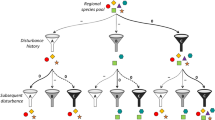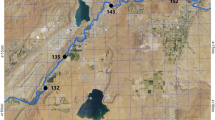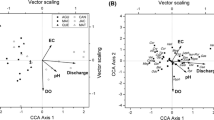Summary
In order to test the role of disturbance and the effects of disturbance frequency on stream communities, an experiment was conducted in New Hope Creek, North Carolina, USA. Patches of cobbles were tumbled 0, 1 or 2 times in a 6 week span. These tumbling disturbances lasted only 30 seconds. The recovery of the macroinvertebrates was monitored.
Most taxa showed major reductions in population density immediately following the disturbance. The percent reduction of a given taxon in disturbed vs. control patches ranged from 21.4–95%. Recovery to near normal population levels was achieved in about four weeks. A second disturbance caused similar population reductions as the first one, and delayed the recovery.
The macroinvertebrate community in cobbles was demonstrated to be resilient in that populations quickly regained their predisturbance densities. Rare taxa did not selectively colonize disturbed patches. The implications of these findings for the intermediate disturbance hypothesis and the structure of stream communities is discussed. Disturbance is a major determinant of lotic community structure and species diversity.
Similar content being viewed by others
References
Allan JD (1982) The effects of reduction in trout density on the invertebrate community of a mountain stream. Ecology 63:1444–1455
Allan JD (1983) Predator-prey relations in streams. In: Barnes JR, Minshall GW (eds) Stream ecology: application and testing of general ecological theory. Plenum Press. N.Y. pp 191–229
Connell JH (1978) Diversity in tropical rainforests and coral reefs. Science 199:1302–1310
Culp JM, Davies RW (1985) Responses of benthic macroinvertebrate species to manipulation of interstitial detritus in Carnation Creek, British Columbia. Can J Fish Aquat Sci 42:139–146
Diamond JM (1982) Stream geomorphology and benthic habitat predictability as determinents of the population dynamics and life history of the snail Juga plicifera. J Freshwat-Ecol 1:577–588
Diamond JM (1984) History disturbance and abiotic factors: effects of lotic macroinvertebrate colonization. Unpublished Ph.D. Dissertation. Univ. of N Carolina
Fisher SG (1983) Succession in streams. In: Barnes JR, Minshall GW (eds) Stream ecology: application and testing of general ecological theory. Plenum Press, NY pp 7–27
Fisher S, Gray L, Grimm M, Busch D (1982) Temporal succession in a desert stream following flooding. Ecol Monogr 52:93–110
Gray LJ, Fisher SG (1981) Post flood recolonization pathways of macroinvertebrates in a lowland Sonoran Desert stream. Amer Midl Natur 106:29–257
Hart DD (1978) Diversity in stream insects: regulation by rock size and microspatial complexity. Vehr Internat Verein Limnol 20:1376–1381
Hart DD (1983) The importance of competitive interactions within stream populations and communities. In: Barnes JR, Minshall GW (eds) Stream Ecology: application and testing of general ecological theory. Plenum Press, NY pp 99–138
Hemphill N, Cooper SD (1983) The effect of physical disturbance on the relative abundances of two filter-feeding insects in a small stream. Oecologia (Berlin) 58:378–382
Horn HA (1966) Measurement of “overlap” in comparative ecological studies. Amer Natur 100:419–424
Lamberti GA, Resh VH (1983) Stream periphyton and insect herbivores: an experimental study of grazing by a caddisfly population. Ecology 64:1124–1135
McAuliffe JR (1984a) Competition for space, disturbance, and the structure of a benthic stream community. Ecology 65:894–908
McAuliffe JR (1984b) Resource depression b a stream herbivore: effects on distributions and abundance of other grazers. Oikos 42:327–333
Minshall GW, Minshall JN (1977) Microdistribution of benthic invertebrates in a Rocky Mountain (USA) stream. Hydrobiologia 55:231–249
Moon HP (1939) Aspects of the ecology of aquatic insects. Trans Soc Brit Ent 6:39–49
Obendorfer RY, McArther JV, Barnes JR, Dixon J (1984) The effect of invertebrate predators on leaf litter processing in an alpine stream. Ecology 65:1325–1331
Paine RT (1966) Food web complexity and species diversity. Amer Natur 100:65–75
Peckarsky BL (1979) Biological interactions as determinants of distributions of benthic invertebrates within the substrate of stony streams. Limaol and Oceanogr 24:59–68
Peckarsky BL, Dodson SI (1980a) Do stonefly predators influence benthic distributions in streams? Ecology 61:1275–1282
Peckarsky BL, Dodson SI (1980b) An experimental analysis of biological factors contributing to stream community structure. Ecology 61:1238–1290
Rabeni CF, Minshall GW (1977) Factors affecting microdistribution of stream benthic insects. Oikos 29:33–43
Reice SR (1974) Environmental patchiness and the breakdown of leaf litter in a woodland stream. Ecology 55:1271–1282
Reice SR (1977) The role of animal associations, current velocity and sediments in lotic litter decomposition. Oikos 29:357–365
Reice SR (1980) The role of substratum in benthic macroinvertebrate microdistribution and litter decomposition in a woodland stream. Ecology 61:580–590
Reice SR (1981) Interspecific associations in a woodland stream. Can J Fish Aquat Sci 38:1271–1280
Reice SR (1983) Predation and substratum: factors in lotic community structure. In: Fontaine TD, III Bartell SM (eds), Dynamics of lotic ecosystems, Ann Arbor Science. pp 325–345
Reice SR (1984) The impact of disturbance frequency on the structure of a lotic riffle community. Vehr Internat Verein Limnol 22:1906–1910
Root RB (1983) Organization of a plant-arthropod association in simple and diverse habitats: the fauna of collards (Brassica oleracea). Ecol Manog 43:95–124
Schoener TW (1983) Field experiments on interspecific competition. Amer Natur 122:240–285
Siegfried CA, Knight AW (1977) The effects of washout in a Sierra foothill stream. Amer Midland Naturalist 98:200–207
Stanford JA, Ward JV (1983) Insect species diversity as a function of environmental variability and disturbance in stream systems. In JR Barnes and GW Minshall (eds) Stream ecology: application and testing of general ecology theory. Plenum Press, NY. pp 265–278
Thorup J (1970) The influence of a short-termed flood on a springbrook community. Arch Hydrobiol 66:447–457
Underwood AJ, Denley EJ (1984) Paradigms, explanations and generalizations in models for the structure of intertidal communities on rocky shores. In: Ecological Communities. Strong DR (eds) Princeton Univ Press, NJ pp 151–180
Vannote RL, Minshall GW, Cummins KW, Sedell JR, Cushing CE (1980) The river continuum concept. Canadian Journal of Fisheries and Aquatic Science 376:130–137
Vannote RL, Sweeny BW (1980) Geographic analysis of thermal equilibria: a conceptual model for evaluating the effect of natural and modified thermal regimes on aquatic insect communities. Amer Natur 115:667–695
Walton OE Jr (1980) Invertebrate dirft from predator-prey associations. Ecology 61:1486–1497
Walton OE Jr, Reice SR, Andrews RW (1977) The effects of density, sediment particle size and velocity on drift of Acroneuria abnormis (Plecoptera). Oikos 28:291–298
Ward JV, Stanford JA (1983 b) The intermediate-disturbance hypothesis: and explanation for biotic diversity patterns in lotic ecosystems. pp 356–397 in Dynamics of Lotic Ecosystems. Fontaine III TD, Bartell SM (eds) Ann Arbor Science pp 356–397
Whittaker RH (1975) Communities and ecosystems. 2nd ed McMillan Publishing Co, NY p 387
Wiens JA (1977) On competition and variable environments. Amer Sci 65:590–597
Williams DD, Hynes BN (1976) The recolonization mechanisms of stream benthos. Oikos 27:265–272
Author information
Authors and Affiliations
Rights and permissions
About this article
Cite this article
Reice, S.R. Experimental disturbance and the maintenance of species diversity in a stream community. Oecologia 67, 90–97 (1985). https://doi.org/10.1007/BF00378456
Received:
Issue Date:
DOI: https://doi.org/10.1007/BF00378456




